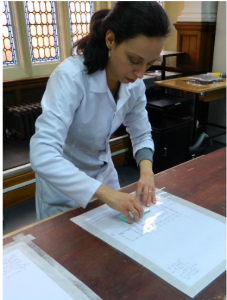Thais Biazioli de Oliveira
 The keenness to improve her practical skills as a paper conservator has led Thais to the Masters at Northumbria University in 2014, having Jane Colbourne as a tutor. This eye-opening opportunity honed her analytical thinking in conservation and complemented her previous working experience in Brazil.
The keenness to improve her practical skills as a paper conservator has led Thais to the Masters at Northumbria University in 2014, having Jane Colbourne as a tutor. This eye-opening opportunity honed her analytical thinking in conservation and complemented her previous working experience in Brazil.
Honoured with a Horizon 2020 and Marie Curie fellowship in 2019 allowed Thais to attend to the Tech for Culture PhD program at University of Turin, a second to none opportunity to achieve her professional goals with great outcomes from the interdisciplinary scientific training.
Among the outcomes from Thais’ research project at the University of Turin were contributions to long-term collection care of artworks of Letraset built though analytical and accelerated ageing tests, complemented with interviews as well as the evaluation of the conservation condition of natural degraded artworks and architectural drawings from the collections of the Tate Galleries and the Maxxi Museum.
The social and historical context of the dry transfer invention, its specificities, its uses on the creation of artworks and eventual conservation issues observed throughout the years were investigated through interviews with Letraset users (artists, architects and designers) and bibliographic research on the Letraset company, the development of dry transfers and the introduction of non-traditional materials in art production.
The presence of Letraset in collections and the materials to what it is most frequently attached to were surveyed through databases of collections, artistic portfolios or Raisonneé catalogues. Although, a precise quantification of Letraset’s presence in collections was obtrude by incomplete descriptions, absence of controlled vocabularies and language barriers, the data obtained suggests that works with Letraset are mainly hosted in Anglo-Saxon collections and were mostly produced during the 1970s, a period that Letraset was extensively available worldwide, with important additions after the 2000s during its recent revival.
The characterisation of white and black Letraset produced in England between 1968 and 1977 involved analyses of ATR-FTIR, EGA/MS and PY-GC/MS that allowed the disclosure of changes in formulation around 1975 and the identification of components not described on patent records, such as the presence of fire retardants. Complementary information regarding Letraset long term stability and degradation patterns were obtained through light and humidity ageing tests and the results were confronted with naturally aged items from Tate Galleries and Maxxi Museum, ensuring that degradation patterns artificially stimulated are correlated with the naturally occurring ones.
Samples were monitored with microscopic images and colorimetric and ATR-FTIR analyses were performed regularly up to 1100 hours of artificial ageing to track the degradation process through the study of degradation indicators as well as colour and functional groups changes. Additional information was obtained with PY-GC/MS and gloss measurements performed before and after ageing.
Some colour change was observed on both black and white transfer letters during light ageing but none of the changes could be detected by the average human eye what suggests that Letraset has good light fasten stability under indoor conditions filtered by a window.
The greater stability of the black indicia during the colorimetric analyses was confirmed by the ATR-FTIR spectra collected during aging with no significant changes observed on any of the sheets analysed. Conversely, the white indicia showed during aging a clear increase in the intensity of the carbonyl stretching absorption at about 1725 cm-1 as well as a broadening of the peak towards higher wavenumbers what indicates an oxidation of the material that can be correlated to the presence of numerous fractures in the white indicia due its lower conservation conditions before ageing.
The evidences gathered during analytical and accelerated ageing tests contributed to enhance the existent knowledge on Letraset composition, degradation patterns and permit the construction of recommendation enabling conservators to have a more oriented approach during preventive or interventive practices with advances to the long term stability of items containing Letraset.
The research was complemented with bibliographic research on polymeric materials, pressure sensitive adhesive and contemporary art adding historical context regarding the development of polymers, its degradation patterns and its uses in the context of the modern and contemporary artistic production.
Tech4Culture Fellow – Call 2 (2019)
Supervisor: Dominique Scalarone, Chemistry Department
